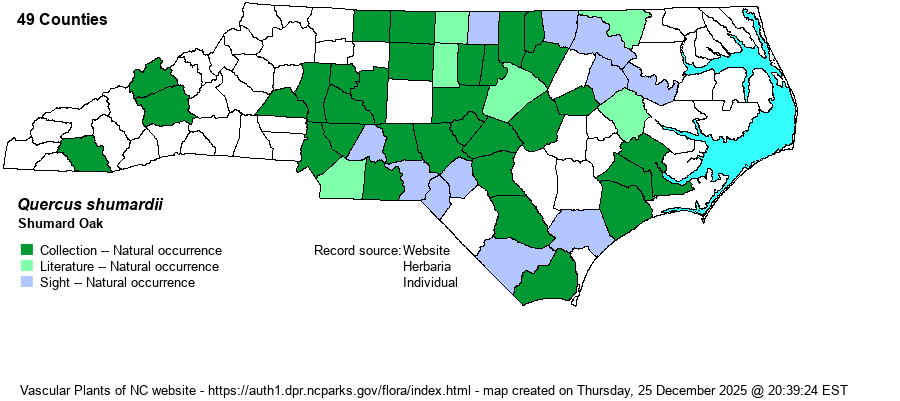| Author | Buckley | |
| Distribution | Throughout the central and eastern Piedmont, and scattered over most of the Coastal Plain. Absent from the northeastern Coastal Plain -– north and south of Albemarle Sound (east of Northampton and Martin counties). Also essentially absent in the western portions of the Piedmont (west of Stokes and Catawba counties). Recorded from several counties in the central and southern Mountains, but otherwise seemingly absent in that province. Note that county records reported in RAB (1968) and even BONAP greatly under-represent the real distribution; biologists are aware of many more county records than shown.
This is primarily a Midwestern species, being found from PA west to KS, and south to central FL and central TX. Its main range is centered from IN to MO and south to AL and LA.
| |
| Abundance | Infrequent to locally fairly common in the Piedmont and along brownwater rivers in the Coastal Plain, though mainly along the Roanoke and Cape Fear rivers there. Generally rare or locally uncommon elsewhere in the Coastal Plain (including the Sandhills, if present there). Extremely rare to absent from the western Piedmont westward. Most numerous in the floodplains of the Roanoke and Cape Fear rivers and major tributaries, into the Piedmont. | |
| Habitat | The species favors very rich, often circumneutral soils of brownwater bottomlands and levees, and on lower slopes over mafic rocks. It rarely can be seen on mid-slopes, but only over mafic rocks. Its most frequent oak associate is Swamp Chestnut Oak (Q. michauxii), which also can be found on lower slopes over mafic rocks. | |
| Phenology | Flowers in April, and fruits from September to October of the second year. | |
| Identification | Despite it not being scarce in the state, it has been somewhat overlooked or misunderstood by older references and many biologists. It is one of the largest trees in the state, perhaps consistently being matched in height by only Tuliptree (Liriodendron tulipifera). This deciduous tree often grows over 100 feet tall, and can reach 120 feet or more. The leaves are quite similar to several other “red oaks”, and the species must be identified with care. The leaves are fairly large, obovate in shape (longer lobes toward the apex), with two or three deep sinuses on each side, yielding several square-shaped lobes with bristle tips -– normally seven lobes in all. The leaves are rather shiny dark green above and paler below but are not thick, and generally are smooth (except for tufted vein axils below). The acorns are large, and the cups are quite flat (not at all conical); if visible, they are helpful in separating the tree from Black Oak (Q. velutina) and Scarlet Oak (Q. coccinea), both of which grow in dry to mesic uplands and have smaller acorns. The combination of rather deeply cut leaves of about seven lobes and the very rich soil (mainly in brownwater bottomlands) usually are suitable for identification. | |
| Taxonomic Comments | A few references provide varieties for the species, but most do not.
| |
| Other Common Name(s) | Shumard’s Oak, Shumard Red Oak, Swamp Red Oak, Spotted Oak | |
| State Rank | S4 | |
| Global Rank | G5 | |
| State Status | | |
| US Status | | |
| USACE-agcp | FAC link |
| USACE-emp | FAC link |

